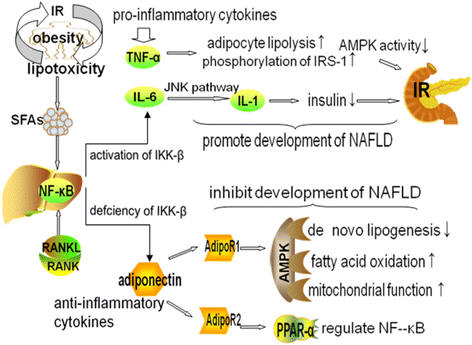A vicious circle between insulin resistance and inflammation in nonalcoholic fatty liver disease
- PMID: 29037210
- PMCID: PMC5644081
- DOI: 10.1186/s12944-017-0572-9
A vicious circle between insulin resistance and inflammation in nonalcoholic fatty liver disease
Erratum in
-
Correction to: A vicious circle between insulin resistance and inflammation in nonalcoholic fatty liver disease.Lipids Health Dis. 2018 Feb 23;17(1):33. doi: 10.1186/s12944-018-0678-8. Lipids Health Dis. 2018. PMID: 29475442 Free PMC article.
Abstract
Nonalcoholic fatty liver disease (NAFLD) comprises a spectrum of diseases, including simple steatosis, nonalcoholic steatohepatitis (NASH), liver cirrhosis and hepatocellular carcinoma. Lipotoxicity, insulin resistance (IR) and inflammation are involved in the disease process. Lipotoxicity promotes inflammation and IR, which in turn, increase adipocyte lipolysis and exacerbates lipotoxicity. Furthermore, IR and inflammation form a vicious circle, with each condition promoting the other and accelerating the development of NAFLD in the presence of lipotoxicity. As an integrator of inflammatory pathway networks, nuclear factor-kappa B (NF-κB) regulates expression of pro-inflammatory cytokines, such as tumor necrosis factor-alpha (TNF-α), interleukin 6 (IL-6), and anti-inflammatory cytokines, such as adiponectin in NAFLD. In this review, the relationships between lipotoxicity, IR and inflammation in NAFLD are discussed, with particular emphasis on the inflammatory pathways.
Conflict of interest statement
Ethics approval and consent to participate
Not applicable.
Consent for publication
Yes.
Competing interests
The authors declare that they have no competing interests.
Publisher’s Note
Springer Nature remains neutral with regard to jurisdictional claims in published maps and institutional affiliations.
Figures

Similar articles
-
The role of bile acids in nonalcoholic fatty liver disease and nonalcoholic steatohepatitis.Mol Aspects Med. 2017 Aug;56:34-44. doi: 10.1016/j.mam.2017.04.004. Epub 2017 May 5. Mol Aspects Med. 2017. PMID: 28442273 Free PMC article. Review.
-
Molecular Mechanisms of Nonalcoholic Fatty Liver Disease (NAFLD)/Nonalcoholic Steatohepatitis (NASH).Adv Exp Med Biol. 2021;1261:223-229. doi: 10.1007/978-981-15-7360-6_20. Adv Exp Med Biol. 2021. PMID: 33783745
-
miR-125b promotes the NF-κB-mediated inflammatory response in NAFLD via directly targeting TNFAIP3.Life Sci. 2021 Apr 1;270:119071. doi: 10.1016/j.lfs.2021.119071. Epub 2021 Jan 28. Life Sci. 2021. PMID: 33515562
-
Non-alcoholic fatty liver disease associated with hepatocellular carcinoma: An increasing concern.Indian J Med Res. 2019 Jan;149(1):9-17. doi: 10.4103/ijmr.IJMR_1456_17. Indian J Med Res. 2019. PMID: 31115369 Free PMC article. Review.
-
Hepatocellular carcinoma and non-alcoholic steatohepatitis: The state of play.World J Gastroenterol. 2016 Feb 28;22(8):2494-502. doi: 10.3748/wjg.v22.i8.2494. World J Gastroenterol. 2016. PMID: 26937137 Free PMC article. Review.
Cited by
-
Iron Fortification and Supplementation: Fighting Anemia of Chronic Diseases or Fueling Obesity?Curr Dev Nutr. 2021 Apr 7;5(4):nzab032. doi: 10.1093/cdn/nzab032. eCollection 2021 Apr. Curr Dev Nutr. 2021. PMID: 33959691 Free PMC article.
-
Insulin Resistance and Diabetes Mellitus in Alzheimer's Disease.Cells. 2021 May 18;10(5):1236. doi: 10.3390/cells10051236. Cells. 2021. PMID: 34069890 Free PMC article. Review.
-
High free sugars, insulin resistance, and low socioeconomic indicators: the hubs in the complex network of non-communicable diseases in adolescents.Diabetol Metab Syndr. 2024 Sep 28;16(1):235. doi: 10.1186/s13098-024-01469-8. Diabetol Metab Syndr. 2024. PMID: 39342282 Free PMC article.
-
Predictors of metabolic-associated fatty liver disease (MAFLD) in adults: a population-based study in Northeastern Iran.Gastroenterol Hepatol Bed Bench. 2021 Fall;14(Suppl1):S102-S111. Gastroenterol Hepatol Bed Bench. 2021. PMID: 35154609 Free PMC article.
-
Maternal Dietary Improvement or Leptin Supplementation During Suckling Mitigates the Long-Term Impact of Maternal Obesogenic Conditions on Inflammatory and Oxidative Stress Biomarkers in the Offspring of Diet-Induced Obese Rats.Int J Mol Sci. 2024 Nov 5;25(22):11876. doi: 10.3390/ijms252211876. Int J Mol Sci. 2024. PMID: 39595945 Free PMC article.
References
-
- Wong RJ, Aguilar M, Cheung R, Perumpail RB, Harrison SA, Younossi ZM, et al. Nonalcoholic steatohepatitis is the second leading etiology of liver disease among adults awaiting liver transplantation in the United States. Gastroenterology. 2015;148(3):547–555. doi: 10.1053/j.gastro.2014.11.039. - DOI - PubMed
Publication types
MeSH terms
Substances
LinkOut - more resources
Full Text Sources
Other Literature Sources
Medical
Research Materials
Miscellaneous

